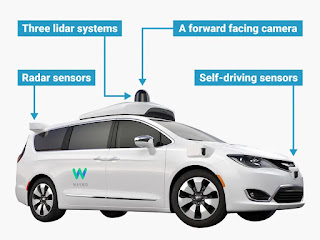Summary reader response Draft 3
Picture of Waymo car
(Gould and Muoio, Business Insider, 2017)
Waymo represents "A New Way Forward in Mobility," a self-driving technology company that originated as a project within Google, integrating a range of advanced features for safety and efficiency. According to Waymo's Blogpost, "The Waymo Driver is our autonomous driving technology that never gets drunk, tired, or distracted" (Waymo, n.d.). Autonomous ride-hailing vehicles, like Waymo, have the potential to significantly improve road safety because of their capacity to lessen risks related to human fatigue, distraction, and impairment. Autonomy's intrinsic benefits point to a safer driving environment with fewer human-related accidents, despite persistent technological obstacles (Hawkins, 2022). These vehicles utilize a combination of lidar, radar, cameras, GPS, and IMU sensors to perceive their surroundings with exceptional precision. High-definition maps provide additional context for navigation, ensuring accurate positioning and route planning. Artificial intelligence and machine learning algorithms analyze sensor data in real-time, enabling the vehicle to make autonomous driving decisions with confidence (Waymo, n.d.). Using these technologies has enabled Waymo to have a breakthrough and attain the Society of Automotive Engineers (SAE) level 4 out of 6. SAE level 4 does not require a driver, allowing their vehicle to operate in specific geographic areas with defined operational conditions (Rambus, 2022).
Waymo's groundbreaking advancements in autonomous vehicle technology, evidenced by its impressive safety record of only three minor injuries in 7.1 million miles, underscore its commitment to revolutionizing transportation through enhanced safety, accessibility for diverse populations, and addressing challenges for widespread adoption, marking a significant milestone in the evolution of autonomous driving.
A key benefit of Waymo's autonomous vehicle technology is its increased Safety: Human error is a major factor in traffic accidents. Waymo is programmed to follow traffic laws and react to situations much faster than humans, potentially leading to a significant reduction in crashes. According to an article, "7.1 million miles, 3 minor injuries: Waymo’s safety data looks good"(Lee, 2023) Through October 2023, Waymo vehicles have had only three crashes with injuries—two in the Phoenix area and one in San Francisco. Waymo says all three injuries were minor. If those same miles had been driven by typical human drivers in the same cities, we would have expected around 13 injury crashes. With the help of technological advancements using lidar, radar, and machine learning, they manage to achieve high precision in their safety to avoid most Human-error accidents.
Apart from its specialty in Autonomous self-driving, Waymo also wishes to improve its accessibility and provide transportation to people who are unable to drive themselves, such as the elderly, the visually impaired, or those with physical disabilities. This could increase their independence and quality of life. Waymo also shows its commitment by partnering with organizations that support disabled people of all ages and abilities. According to Forbes, they partnered up with the American Association of People with Disabilities (AAPD), the American Council of the Blind (ACB), etc. for the Blind and elderly (Aquino,2022). An example would be in Waymo's latest fleet, they have added a new built-in Chime sound to guide the blind and identify the right vehicle to enter. To the consumers, it was euphonious to be able to use this melody instead of the usual car horn, which can be a little cacophonous to others (Malta,2023).
For Waymo, extending its car services to new markets and cities comes with a set of hurdles, including growing expenses, technology advancement constraints, and the difficulties of expanding autonomous vehicle operations across various regulatory laws and geographies. According to Waymo's blog post(, "Before expanding, we ensure we have a comprehensive understanding of the environment we plan to operate and our system’s capabilities". As Waymo is an SAE level 4, it can only operate in certain regions, and uses meticulous data processing and collection are necessary to produce high-definition maps for a variety of geographical areas. Adjusting to local quirks and regularly updating maps are necessary for scaling this process across several locations. According to Waymo's blog post," We continuously iterate and improve our technology and operations through a rigorous process that combines structured testing, simulation, and public road operations so we’re prepared for this next phase."
In conclusion, Waymo's groundbreaking advancements in autonomous vehicle technology, exemplified by its impressive safety record and commitment to accessibility, mark a significant milestone in the evolution of transportation. With a relentless dedication to safety, efficiency, and inclusivity, Waymo is poised to revolutionize mobility, paving the way for a future where autonomous driving enhances safety, independence, and accessibility for all.
References:
Aquino, S. (2022, October 12). This autonomous driving startup announces New Accessibility Network for Disabled Community. Forbes.
https://www.forbes.com/sites/stevenaquino/2022/10/06/in-its-latest-partnership-with-disabled-people-autonomous-driving-startup-waymo-announces-new-waymo-accessibility-network/?sh=38b13ce38d81
From surface streets to freeways, safely expanding our Rider-only testing. Waymo’s blogpost. (2024, January 8).
https://waymo.com/blog/2024/01/from-surface-streets-to-freeways-safely-expanding-our-rider-only-testing/
Hawkins, A. J. (2022, August 9). Waymo designed new features to improve AV access for passengers with disabilities. The Verge.
https://www.theverge.com/2022/8/9/23298488/waymo-accessible-disability-dot-design-challenge-av
Hawkins, A. J. (2022, September 29). Autonomy’s intrinsic benefits. The Verge.
https://www.theverge.com/2022/9/29/23377219/waymo-av-safety-study-response-time-crash-avoidance
Hawkins, A. J. (2023, December 20). Waymo has 7.1 million driverless miles - how does its driving compare to humans? The Verge.
https://www.theverge.com/2023/12/20/24006712/waymo-driverless-million-mile-safety-compare-human
Hope, G. (2023, August 4). Waymo launches AV initiative for people with disabilities. IoT World Today.
https://www.iotworldtoday.com/transportation-logistics/waymo-launches-av-initiative-for-people-with-disabilities#close-modal
How autonomous vehicles work. Let’s Talk Autonomous Driving(Waymo’s Blogpost ). (n.d.).
https://waymo.community/about/how-autonomous-vehicles-work.html#:~:text=Waymo%20is%20building%20a%20driver,stay%20passengers%20the%20entire%20trip
Janouch S. . (2020, December 15). What are all these automotive cameras doing? processors for deep learning, Computer Vision and Video coding
http://www.videantis.com/what-are-all-these-automotive-cameras-doing.html
Lee , T. B. (2023, December 20). 7.1 million miles, 3 minor injuries: Waymo’s Safety Data looks good. Ars Technica.
https://arstechnica.com/cars/2023/12/human-drivers-crash-a-lot-more-than-waymos-software-data-shows/
Rambus. (2022, June 10). SAE levels of automation in cars are simply explained https://www.rambus.com/blogs/driving-automation-levels/
Say hello to Waymo: What’s next for Google’s self-driving car project. Waymo’s Blogpost. (2016, December 13).
https://waymo.com/blog/2016/12/say-hello-to-waymo-whats-next-for/?hl=zh_TW
Waymo’s autonomous vehicles are significantly safer than human-driven ones, says new research led by Swiss re. Waymo’s Blogpost. (2023, September 6).
https://waymo.com/blog/2023/09/waymos-autonomous-vehicles-are-significantly-safer-than-human-driven-ones/


Comments
Post a Comment